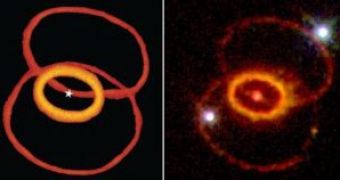Astronomers have been long puzzled by the peculiar pattern of the supernova 1987A.
This supernova blasted within the Milky Way galaxy on 23 February 1987 and is the closest supernova detected since that found by Johannes Kepler in 1604.
The researchers believe that the fusion of two stars and the deadly dance before its consumption determined the distinctive triple ring system.
SN 1987A displays an unusual chemical composition that made many astronomers believe that the progenitor star collided with another star briefly before the explosion. The progenitor star of SN 1987A is wrapped in a gaseous nebula. Before their death, massive stars swelled into red giants before losing as much as half their mass as gas and dust nebulae, often with a pinched aspect.
Nebulae have bizarre and intricate shapes which are difficult to explain.
Recently, Thomas Morris and Philipp Podsiadlowski, both of the University of Oxford, UK, have made a computer simulation of the emergence of the triple rings by the spiraling and fusion of two stars. The speed of the rings' expansion points to an age of roughly 20,000 years to the explosion.
The collision was produced between a 5 solar mass star with a 15 solar mass red giant star, at the core of the giant. The smaller star disturbed the red giant's atmosphere, flattening the gas into a disc and the friction forces also heated up the atmosphere, making it expand outwards in all directions.
Most of this outflow was ejected to the outer part of the disc, inducing two large rings above and below it; but the fusion also sped up the star spinning, making it spit off material at its equator, realizing the third ring. "The spiraling in of a companion star inside a red giant's atmosphere could explain other planetary nebulae, too", said Podsiadlowski. "In most cases, the atmosphere would be entirely ejected before there is a chance for a merger, leaving behind a binary star and a nebula with a somewhat different shape than the one around SN 1987A," he said.
"Roughly 20% of all planetary nebulae are known to have such binary cores. The butterfly shape of a nebula called NGC 2346 might be explained this way, for example," he said.
Noam Soker of Technion University in Haifa, Isreal, a researcher of planetary nebulae, thinks this theory explains well the inner ring, but he does not agree on the appearance of the outer two rings. He gives as examples other nebulae with outflows that come off at an angle, like Eta Carinae and the Red Rectangle, with companions found outside the atmosphere of the progenitor star. "Such nebulae might instead be produced as a result of jets from the central star turned on by interactions with a more distant companion. What I agree with them on is that you must have a companion to form this structure," he said.
"But maybe they are right and I am wrong. I think we don't fully understand yet the formation of nebulae around evolved stars" he added. "Other mechanisms, like the one Soker describes, may be the answer for some other systems, but they cannot explain the triple rings of SN 1987A. There is no other model besides ours at the moment that can produce those," said Podsiadlowski.
Image credit: T. Morris/P. Podsiadlowski
Photo credit: NASA

 14 DAY TRIAL //
14 DAY TRIAL //